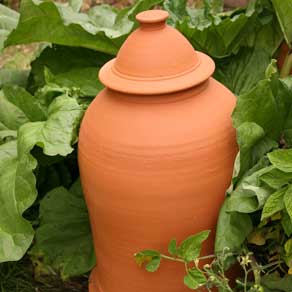Rhubarb is the new healthy eating craze. During the second world war it was part of the countrys' staple diet, providing a fair amount of the nations vitamin C. Eaten in pies, crumbles and fools it kept the homeguard happy. After the war its popularity waned and people lost the taste for its acidic flavour. Now its back on the menu at top eateries where delicate forced rhubarb is served in all manor of dishes. Rhubarb, though is very easy to grow and plants can be easily bought now from local garden shops or centres. The best varieties are Champagne with sweet tasting pink-tinged stems and Timperley Early which is also very flavoursome and great for forcing.
Forcing rhubarb is a way to provide an early crop of very delicate fruit. A rhubarb forcer, rather like a large clay chimney pot, is placed over a rhubarb plant in early spring before growth starts and a lid put on the top. The warmth created by the forcer starts the rhubarb into growth. Once growth is well established the top can be removed to encourage the stems to grow towards the light. Once the stems have been picked the forcer should be removed and the rhubarb plant given a good feed. Plants should only be forced every other year so you'll need two plants to give fruit every year.
Once growth is well established the top can be removed to encourage the stems to grow towards the light. Once the stems have been picked the forcer should be removed and the rhubarb plant given a good feed. Plants should only be forced every other year so you'll need two plants to give fruit every year.
Seakale is forced in a similar way. Buy seakale as root cuttings in spring and leave them to grow for a year before forcing them in the same way as rhubarb. seakale plants don't need a rest between forcings but atfer three years it is usually best to replace them.
Rhubarb is great for the microgarden as it has wonderful decorative leaves and stems, is cheap to buy and no problem to look after.

Comments